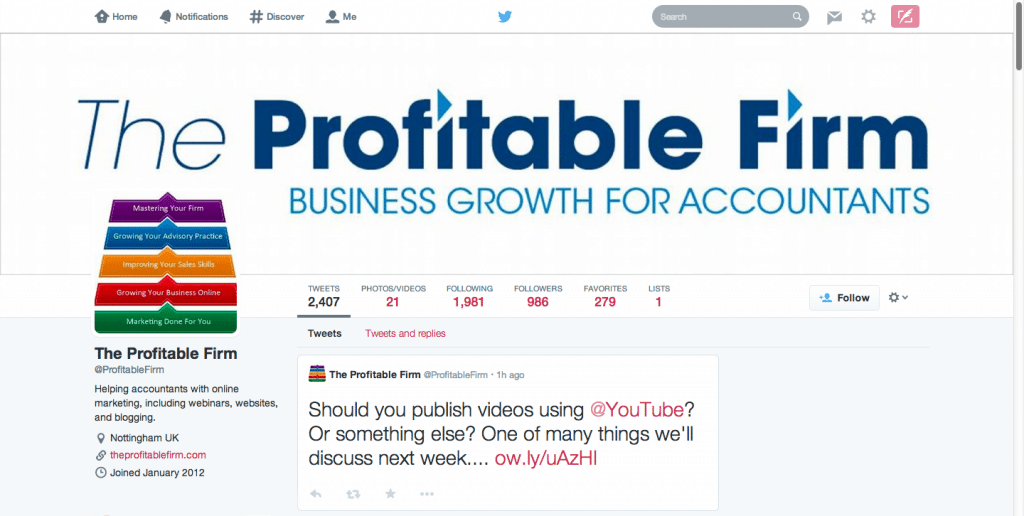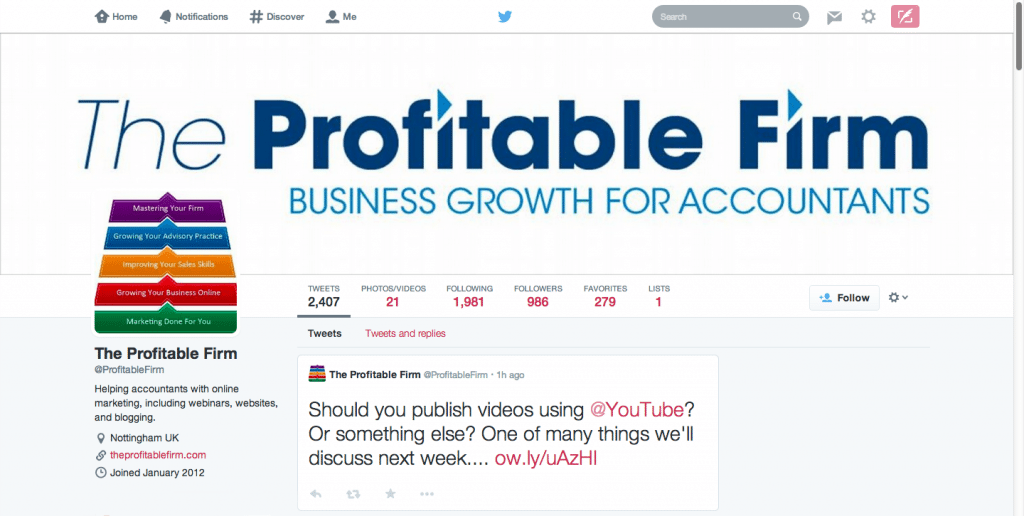 When your accountancy firm is ready to start using Twitter regularly, the first question you’re going to ask yourself is – what in the world do I say? How do I use it? After I’ve mentioned the weather and our new website and the fact that we are now on Twitter, what’s left?
When your accountancy firm is ready to start using Twitter regularly, the first question you’re going to ask yourself is – what in the world do I say? How do I use it? After I’ve mentioned the weather and our new website and the fact that we are now on Twitter, what’s left?
First, we’d strongly recommend you figure out a niche. Or an industry focus. Or something. If you don’t have one, here’s why you should.
Where do I start?
Once you know your niche, you can then:
- Follow anyone related to your niche. People, businesses, organisations, strategic partners, whatever.
- Engage with your niche specifically.
- Create good calls to action for your niche. Read more here. Once you have these, you’ve got great links to share on Twitter when it’s relevant.
- Craft specific updates for your niche. For example, when the Budget comes out, don’t write a generic update. Write twelve separate updates for various niche areas – startups, dual-income families, people who own holiday homes, whatever. Make it about them, specifically. Make them want to click it.
What should I do?
Other than that, here are 13 things you can share or do on Twitter for your accountancy firm:
- Make recommendations. Tell the world how great your website designer/stationery supplier/coffee company is.
- Introduce two people you think should connect. “@PersonA meet @PersonB, you guys are both creatives and think alike!”
- Share reports or ebooks that you enjoyed downloading or reading
- Share a presentation from Slideshare
- Share a new restaurant or business idea.
- Share blog posts
- Share videos
- Share events you are hosting or attending or that you think are interesting
- Share local news or gossip
- Use an event hashtag (like #xerocon or #infusioncon) when heading to an event or conference. Talk about it. Connect with others going there. Follow up with them afterwards.
- Re-share an old blog post (yours or someone else’s), as long as the content is still relevant
- Share a link to a poll or survey you found interesting, or want others’ thoughts on
- Link to good posts on Facebook, LinkedIn, or other platforms
Above all, just get on Twitter a few times a day, scroll through what’s been happening. Reply, retweet, quote tweets, share links, follow people, thank people for following. It really is that simple.
You can also use Twitter ads to get some of your posts promoted, so that you get more followers of the type you want – or more click throughs to something important.
How to deal with leads
If you get a lead or a new opportunity via Twitter, no matter where it comes from, here’s how to deal with it:
- Reply to their tweet like you would if they sent you a personal email. For instance, you could say, “hey [person], would love to help! Let me know what’s the best way to get in touch – email or phone? Or drop me a note here [link to your contact form]”. (The reason for using your contact form is it forces them to go to your firm’s website, and it prevents your email address from going out and being more subject to spammers.)
- If appropriate, direct them to specific pages on your site. For example, if you specialise in creative agencies, and one gets in touch, send them directly to the landing page on your site related to creative agencies.
- Follow them. Retweet a few of their tweets (if they’re interesting!) or reply to one or two. Don’t stalk them – just be interested in who they are and what they’re saying.
- Follow up. Use Hootsuite or some other system to keep track of your leads and if you don’t hear anything in a day or two, get in touch again. Don’t pressure them to “buy” – just think of something useful they might like, and share it.
In my next post we’ll look at what not to say and do on Twitter!

